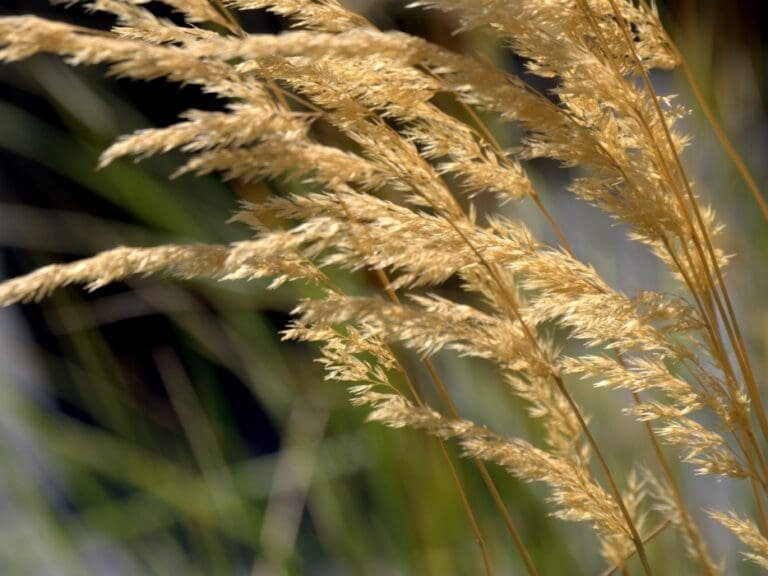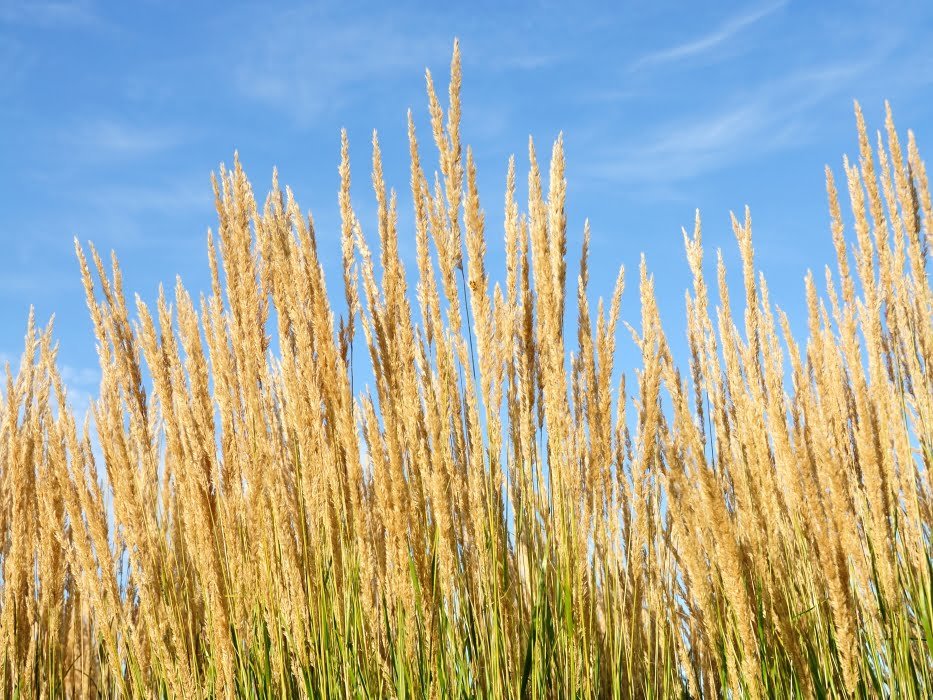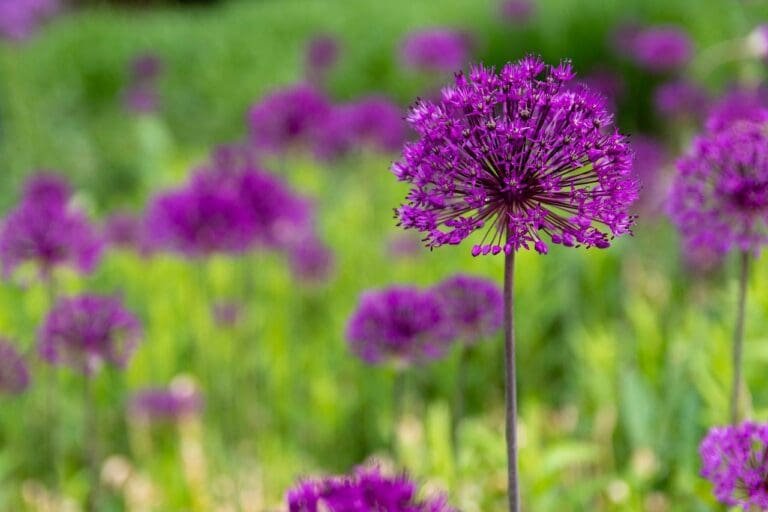Calamagrostis ‘Karl Foerster’ has become one of my favourite ornamental grasses. With its tall, narrow growth habit and soft, feathery bronze-green flower plumes, it brings unique texture and visual interest to any garden. The slender green blades provide a graceful, delicate texture while the wheat-coloured seed heads sway attractively in the breeze. I find it to be an extremely versatile and beautiful plant.
Ornamental grasses like this are important in landscaping because they provide year-round visual appeal and movement with their flowing, swaying foliage.
They add texture and contrast to gardens dominated by shrubs and broad-leaved perennials. Grasses help create a sense of depth and naturalism in designed landscapes.
Top Tip
Use Karl Foerster’s narrow vertical shape as a backdrop to anchor island beds or plant en masse for a contemporary, cohesive look.
This post contains affiliate links which means we may make commission from any qualifying sales with no extra cost to yourself.
Calamagrostis ‘Karl Foerster’ – History and Origin
Karl Foerster (1874-1970) was a famous German plantsman who bred numerous popular garden cultivars. He discovered and selected Calamagrostis acutiflora ‘Karl Foerster’ in the garden of his nursery in Potsdam, Germany in the 1950s. It was introduced commercially in Germany in 1956 and came to the United States in the 1970s. ‘Karl Foerster’ has proven to be one of the most popular ornamental grass introductions of all time.
Characteristics and Features – Calamagrostis ‘Karl Foerster’

Calamagrostis Karl Foerster grows in narrow, upright clumps up to 5 feet tall and 2 feet wide. The slender, erect, grey-green blades have prominent veins giving them a graceful, delicate appearance.
Tawny bronze plumes emerge in early summer, maturing to wheat-coloured seed heads in fall. The feathery flower heads provide light, airy texture, emerging pink-tinged then drying to a blonde shade. The foliage turns yellow in autumn, providing a pop of colour before going dormant for winter.
One of the best features of Karl Foerster is that it remains sturdily upright and dense throughout the seasons without flopping over like some other grasses. This makes it an excellent vertical accent plant.
Planting and Care
Care
Caring for Karl Foerster includes watering during drought to prevent foliage from wilting. Apply a balanced fertilizer in early spring to encourage growth. Cut back dead foliage in late winter just before new growth emerges. Remove spent flower plumes if they become unsightly. Every 3-5 years, congested clumps can be divided in early spring to rejuvenate the planting.
Pests/Diseases
In general, Karl Foerster feather reed grass is pest and disease free. Occasionally it may be affected by powdery mildew, but this is not common. Proper cultural practices like pruning for air circulation and watering early in the day help prevent disease issues.
Landscaping and Design

With its vertically oriented shape, Karl Foerster makes a dramatic accent or foliage backdrop. It is effective in mass plantings, borders, and containers. This grass combines beautifully with perennials like asters, sedums, Russian sage and other late summer bloomers.
The delicate texture and swaying habit of Karl Foerster provides pleasing movement and contrast to landscapes. It also offers great seasonal interest. The green spring foliage turns golden in fall before fading to blonde for winter. Soft, wheat-like summer plumes last into winter.
Uses and Benefits

Ecological Value
Karl Foerster does not spread aggressively, so it won’t crowd out other plants. The seeds provide food for songbirds. It is also a host plant for some butterfly larvae like skippers.
Aesthetic Value
This ornamental grass makes an excellent vertical accent that does not block views. The soft texture and subtle colour changes provide visual interest. Karl Foerster sways gracefully in the breeze for constant movement. The yellow fall colour is followed by attractive dried plumes that provide winter interest.
Final thoughts
With its finely textured beauty and graceful form, Calamagrostis Karl Foerster is one of the most valued ornamental grasses. This versatile, trouble-free plant enhances landscapes with its attractive foliage, blooms, and fall colour. Karl Foerster feather reed grass deserves a spot in gardens where its delicate texture and swaying habit can be fully appreciated.
Frequently Asked Questions
Q. How big does Calamagrostis Karl Foerster grow?
Calamagrostis Karl Foerster is a medium-sized grass, growing in upright, narrow clumps to around 4-5 feet tall and 2 feet wide. It maintains a dense, vertical form without flopping over. The green foliage height reaches 3-4 feet, with the feathery flower plumes extending another 12+ inches above the leaves from early to late summer. Karl Foerster does not spread aggressively and maintains a tidy habit.
Q. Where is the best place to plant Karl Foerster grass?
This ornamental grass thrives in full sun to part shade exposure. It performs best in moist, well-drained soil and appreciates consistent moisture. For optimum growth and to prevent flopping, plant Karl Foerster grass in sheltered spots protected from strong winds. Use it as a specimen plant, in borders or mass plantings, in containers, and in rain gardens or other landscape accents where its form can be shown off.
Q. Does Calamagrostis spread?
No, Karl Foerster is a clump-forming grass and does not spread through underground rhizomes. It grows in a slowly-expanding upright clump, but is non-invasive. Occasional division may be needed if the clump becomes too dense. It does self-seed a bit close to the parent plant, but not aggressively.
Q. How far down to cut Calamagrostis Karl Foerster grass?
Cut back the previous year’s foliage to around 3-5 inches above the ground in late winter or early spring. Removing accumulated debris helps encourage fresh new growth. Cutting too short can damage the crown. Dead flower plumes can be trimmed back anytime for neatness.
Q. When should you cut down Calamagrostis Karl Foerster grass?
The ideal time for cutting back Calamagrostis Karl Foerster is late winter or early spring, before new growth begins. Remove foliage down to a few inches above soil level to tidy up the plant before spring green-up. Avoid cutting back in fall so that the remaining blonde plumes can provide winter interest.


